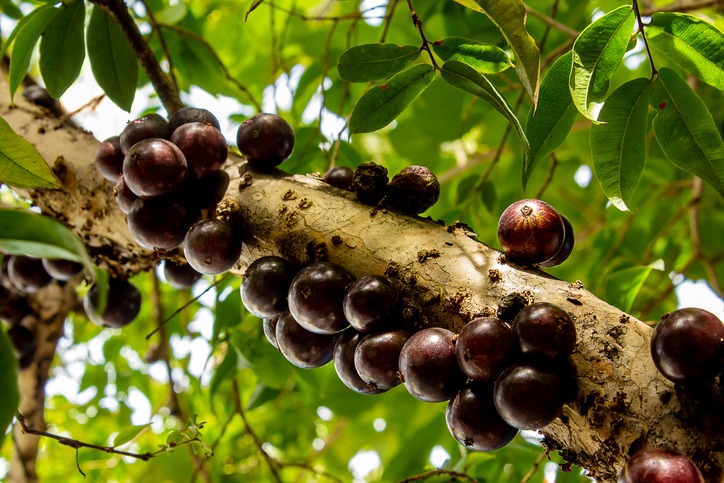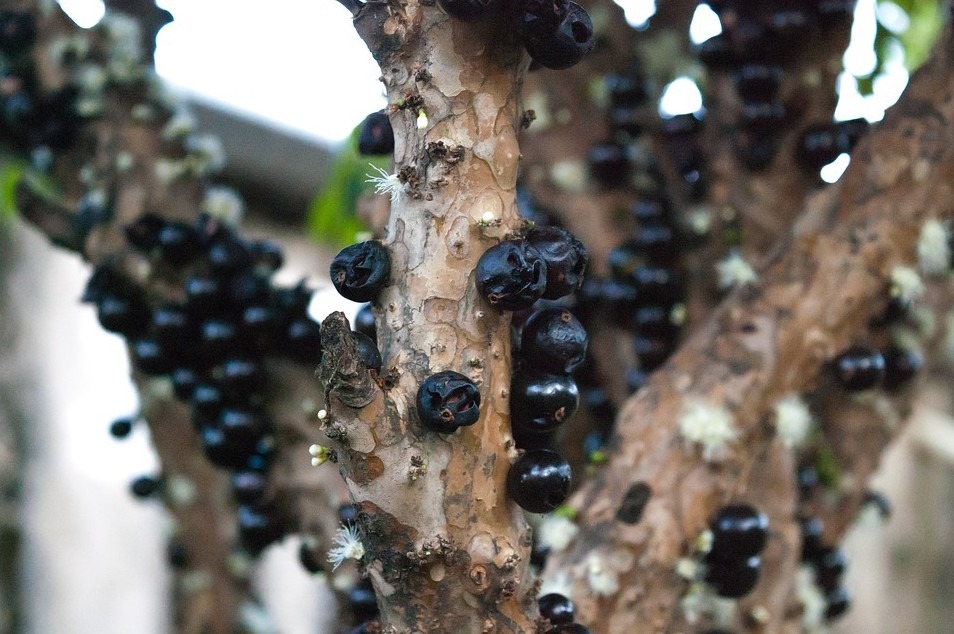Jaboticabas are large, rounded, purple tropical fruits that are native to Brazil. The exotic-sounding grapefruit is also known as the Brazilian grape tree. It is a slow-growing evergreen with heights up to 15 meters. Unlike most of the trees that carry their fruit on the branches’ ends, Jaboticabas bear fruits on their trunk and inner limbs. Its delicious white-pulp can be eaten raw or turned into jellies or wine.
Four species of Jaboticaba are native to Minas Gerais, Brazil. It is mostly cultivated from the southern Rio Grande to Bahia, and from the Goyaz to Mato Grosso. Other species are indigenous to the South American countries like Bolivia, Northeastern Argentina, Paraguay, Uruguay, and Peru.
The Jaboticaba flowers are small and yellow-white that dramatically emerges from the trunks in groups of four. Meanwhile, its fruit has a grape-like appearance but with thicker and tougher skin. The average sizes of the fruit are ¾ to 1 inch in diameter. The soft white pulp contains one to three seeds.
Growing a Jaboticaba Tree
As a tropical plant, Jaboticaba will thrive well in places with ample sunlight and rainfall. In snowy regions, the tree can handle down to 20 degrees celsius. It can live in most types of soil – from moist and rich loam to alkaline beach-sand. It could also thrive in places with high acidity provided that it is regularly treated and irrigated.
Growing the tree from the seeds is the most common way of propagating it. You will then have the option to either plant it directly on the soil or have it grow in a container in the first year (so you could quickly transfer it to places with enough sunlight or protect it from freezing cold). In summer months, never allow your tree to dry out. If possible, flood the tree once in a while to wash out the excess salts in the soil. They easily get salt burns similar to blueberries.
To ensure fresh fruit available year-round, treat your tree with fertilizers every four months. Without this cultivation, the tree will only bear fruit once or twice a year. If your soil is too acidic, use sulfur to bring down the pH level. Additionally, consider investing in iron minerals (chelated iron) as it is what the plant needs the most.
If you have extra space in your backyard, plant multiple Jaboticaba trees. Cross-pollination enhances productivity and fruit yield.
Potential Problems
Fruits and flowers of Jaboticaba plants are susceptible to fungus, pests, and animal attacks. During flower season, birds and raccoons are attracted to it. The most dangerous ones are the tiny pests that may feed on your plants anytime. Aphids and scales are the two most common pests that feed on Jaboticaba plants.
Aphids feed on plants that cause stunted growth and yellowing of leaves. As they feed on the tree, they secrete a sticky substance that quickly becomes infested with black mold. Although it is possible to use chemicals to remove them from the tree, it is much preferred to kill them organically. One way to do it is to pamper and nature beneficial bugs like lacewings and ladybugs. Planting mint, fennel, and dandelions near the Jaboticaba tree can help attract these insects.
Scales are small, oval insects that suck sap from the plants’ branch, robbing them of essential nutrients. Like the aphids, scales also excrete a substance that encourages the growth of black molds. These molds interfere with photosynthesis, which is very unhealthy for saplings or young trees. There is no easy cure for this type of insect, but you can gently pick them off from the plant one by one. For severe infestations, use insecticide sprays like neem oil and follow it up with a crawler.
Harvesting and Commercial Potential
Ripe Jaboticaba fruits look like ripe grapes as well. Fresh fruits start to ferment three days after they were harvested. Freshly picked fruits are mostly eaten out of hand. Others peel the fruits and make jellies and marmalades. Meanwhile, Brazilians love turning their Jaboticaba into old wines.
The fruit is very common in Brazilian and other South American markets. However, due to its short shelf life, fresh fruits are seldomly sold in open-air stores outside cultivation areas. Aside from its fruits, grafted Jabuticabas are used as bonsai or container ornamental plants in tropical regions.


